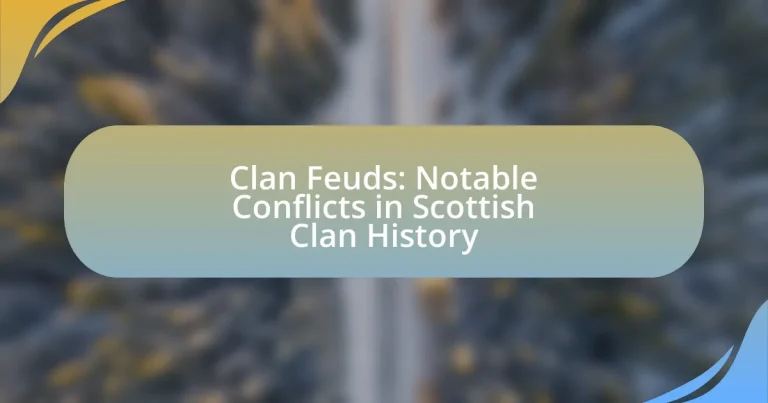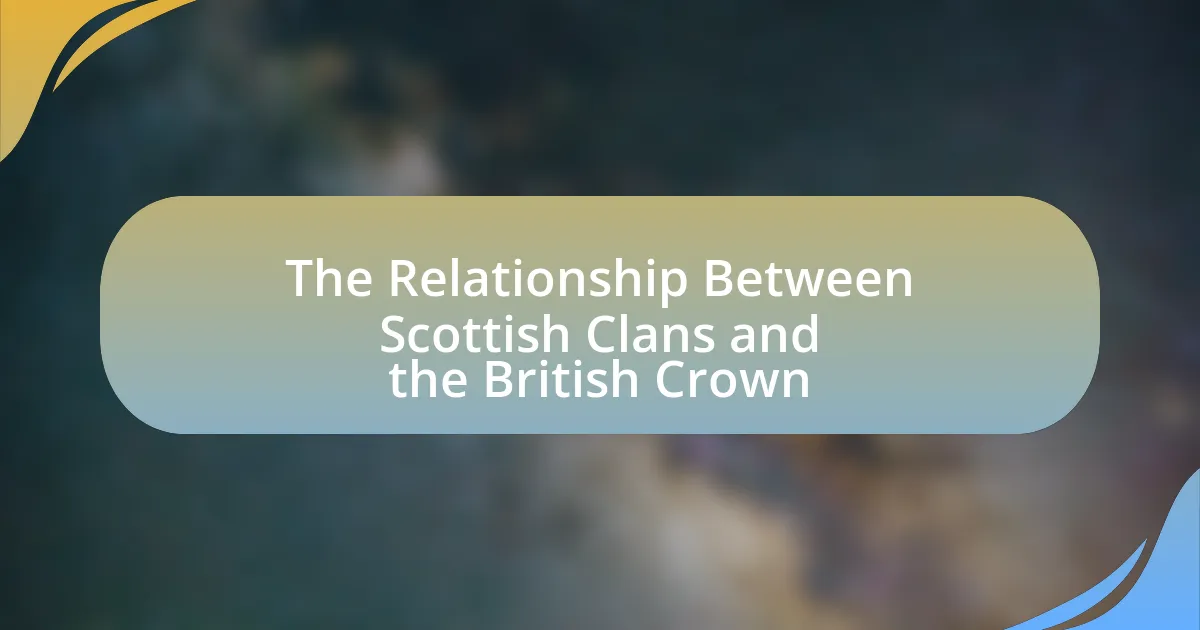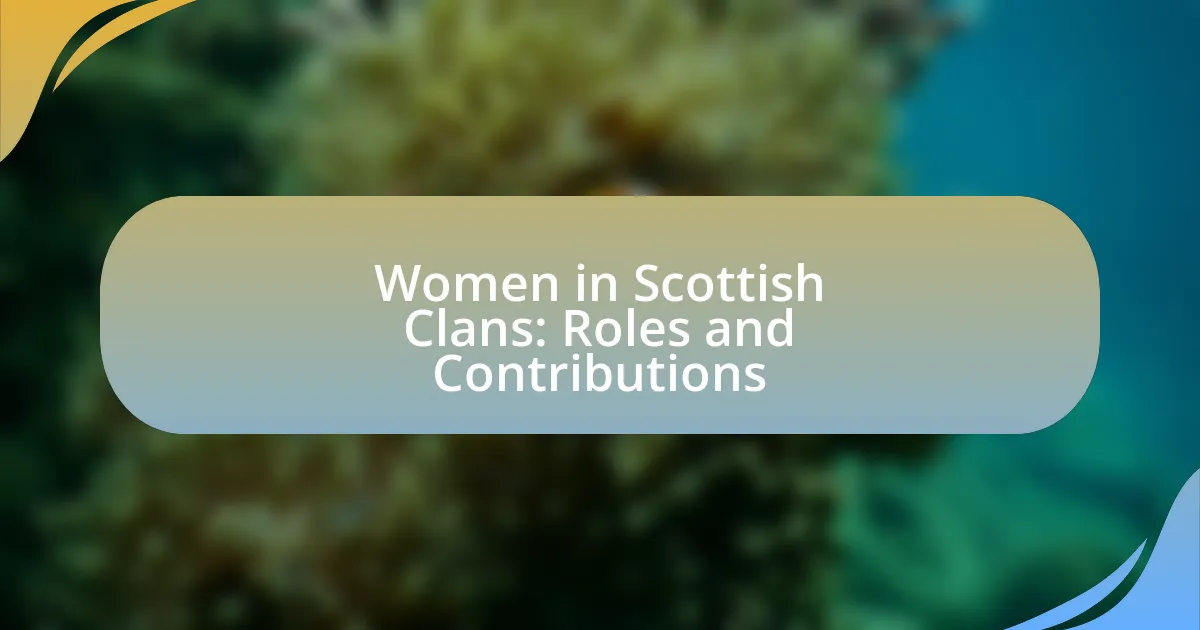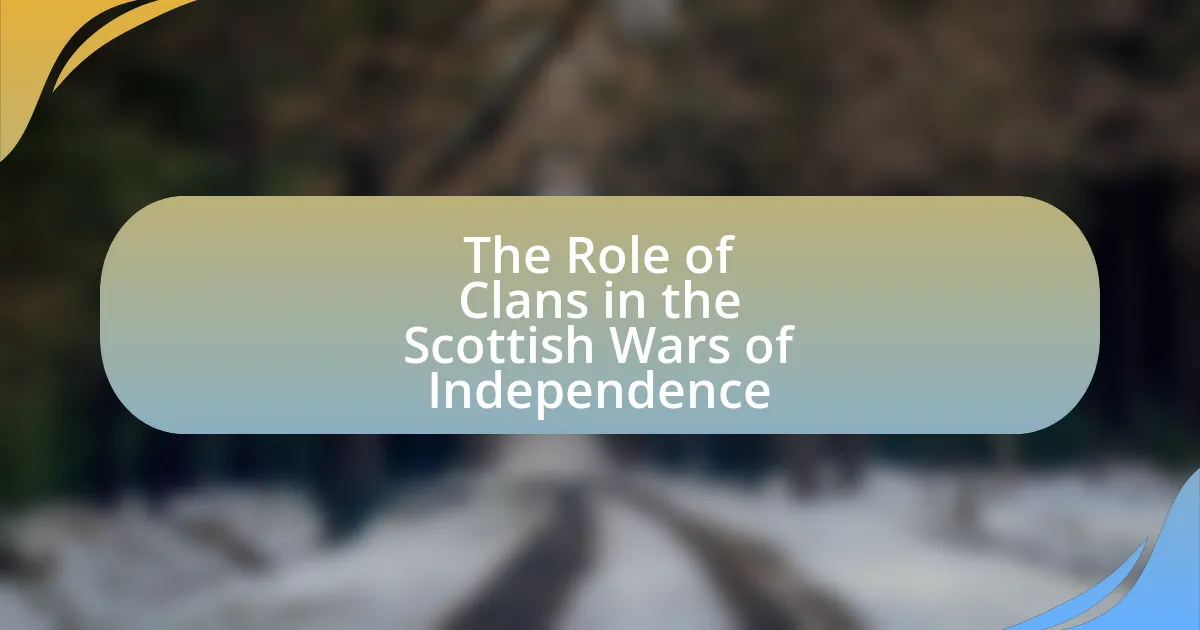Clan feuds in Scottish history refer to long-standing conflicts between various clans, often marked by violence, revenge, and territorial disputes. These feuds originated from competition for land and resources, exacerbated by the absence of centralized authority, leading to significant bloodshed and lasting animosities. Key examples include the notorious rivalries between the MacDonalds and the Campbells, as well as the MacKenzies and the MacLeods, which shaped the social and political landscape of Scotland from the medieval period into the 18th century. The article explores the origins, social and political factors, geographical influences, and the cultural legacies of these feuds, highlighting their impact on Scottish society and modern conflict resolution strategies.
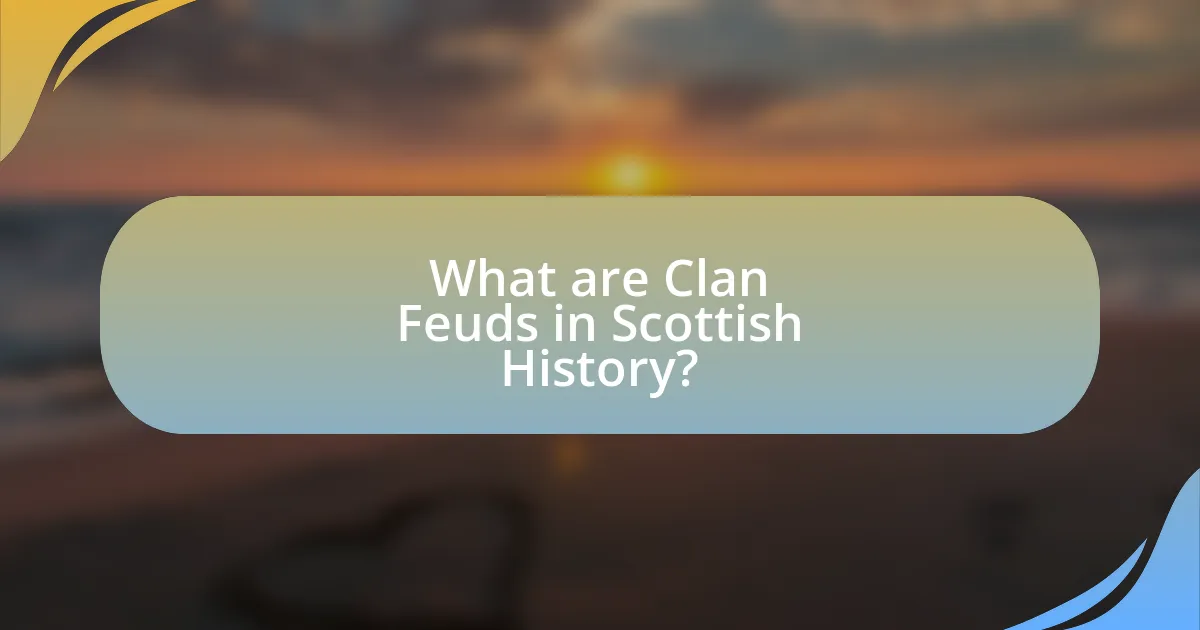
What are Clan Feuds in Scottish History?
Clan feuds in Scottish history refer to long-standing conflicts between different clans, often characterized by violence, revenge, and territorial disputes. These feuds were fueled by factors such as competition for land, power struggles, and personal vendettas, leading to significant bloodshed and lasting animosities. Notable examples include the feud between the MacDonalds and the Campbells, which resulted in numerous battles and skirmishes throughout the Highlands. Historical records indicate that such feuds were common from the medieval period into the 18th century, shaping the social and political landscape of Scotland during that time.
How did Clan Feuds originate in Scotland?
Clan feuds in Scotland originated primarily from territorial disputes, competition for resources, and the desire for power among clans. These conflicts were exacerbated by the lack of centralized authority, leading clans to engage in violent confrontations to assert dominance over land and influence. Historical records indicate that feuds often stemmed from incidents such as cattle raiding, which were common practices among clans, further intensifying rivalries. Notable examples include the long-standing feud between the MacDonalds and the Campbells, which illustrates how personal grievances and historical grievances could escalate into broader conflicts.
What social and political factors contributed to the emergence of Clan Feuds?
Social and political factors that contributed to the emergence of Clan Feuds include territorial disputes, power struggles, and kinship ties among clans. Territorial disputes arose from competition for land and resources, often leading to violent confrontations. Power struggles were exacerbated by the feudal system, where clan leaders sought to assert dominance over rivals, resulting in ongoing conflicts. Additionally, kinship ties created a sense of loyalty and obligation, compelling clans to defend their honor and retaliate against perceived slights or attacks from other clans. Historical records indicate that these feuds were often fueled by alliances and enmities formed through marriage and political maneuvering, further entrenching divisions and hostilities among clans.
How did the geography of Scotland influence these conflicts?
The geography of Scotland significantly influenced clan conflicts by creating natural barriers and strategic advantages. The rugged terrain, including mountains and glens, provided hiding places and defensive positions for clans during skirmishes. For instance, the Highlands’ isolation allowed clans to maintain autonomy and engage in feuds without interference from central authority. Additionally, the proximity of clans to valuable resources, such as fertile lands and trade routes, intensified competition and conflict. Historical events, such as the Battle of Culloden in 1746, illustrate how geography shaped the battlefield dynamics, with the terrain affecting troop movements and strategies.
What role did loyalty and honor play in Clan Feuds?
Loyalty and honor were central to clan feuds, serving as the driving forces behind alliances and conflicts among Scottish clans. Loyalty to one’s clan dictated actions and decisions, often leading to violent confrontations when honor was perceived to be at stake. For instance, the MacDonald and Campbell clans engaged in numerous feuds fueled by perceived slights and betrayals, where loyalty to clan leaders and the defense of familial honor justified retaliatory violence. Historical records, such as the feud between the MacGregors and the Campbells, illustrate how breaches of honor could escalate into prolonged conflicts, emphasizing that loyalty and honor were not merely personal virtues but essential components of clan identity and survival.
How did clan loyalty shape the nature of these conflicts?
Clan loyalty significantly influenced the nature of conflicts in Scottish clan history by fostering intense rivalries and alliances that dictated the course of battles. This loyalty often led clans to engage in feuds over territory, honor, and resources, as seen in notable conflicts such as the feud between the MacDonalds and the Campbells, where loyalty to clan identity fueled violent confrontations. The deep-rooted allegiance to clan leaders and kinship ties created a social structure where disputes were often settled through warfare rather than negotiation, reinforcing the cycle of conflict. Historical records indicate that clan loyalty was so paramount that it could override personal grievances, leading entire clans to mobilize in defense of their kin, as exemplified during the Wars of Scottish Independence when clans united against external threats.
What were the consequences of dishonor among clans?
Dishonor among clans often resulted in severe consequences, including violent feuds, loss of alliances, and social ostracism. For instance, in Scottish clan history, a breach of honor could lead to retaliatory attacks, as clans sought to restore their reputation and avenge perceived slights. This cycle of violence not only escalated conflicts but also disrupted trade and alliances, as clans became wary of each other. Additionally, dishonor could lead to the expulsion of members from their clan, further weakening their social structure and cohesion. Historical records indicate that such conflicts often resulted in significant casualties and long-lasting enmity between clans, exemplifying the profound impact of dishonor in clan dynamics.
What were the most notable Clan Feuds in Scottish history?
The most notable clan feuds in Scottish history include the conflicts between the MacDonalds and the Campbells, the MacKenzies and the MacLeods, and the feud between the Clan Gordon and the Clan Grant. The MacDonald-Campbell feud, particularly during the 17th century, was marked by violent confrontations, including the Massacre of Glencoe in 1692, where members of the MacDonald clan were killed by government forces allied with the Campbells. The MacKenzie-MacLeod feud, which spanned several centuries, involved territorial disputes and battles over land and influence in the Hebrides. The Gordon-Grant feud, prominent in the 16th century, was characterized by a series of skirmishes and retaliatory attacks, reflecting the intense rivalry for power in the Highlands. These feuds were significant in shaping clan dynamics and Scottish history.
Which clans were involved in the most significant feuds?
The clans involved in the most significant feuds in Scottish history include the MacDonalds and the Campbells, as well as the MacKenzies and the MacLeods. The feud between the MacDonalds and Campbells, particularly during the 17th century, was marked by violent confrontations and territorial disputes, notably the Massacre of Glencoe in 1692, where members of the MacDonald clan were killed by government forces allied with the Campbells. Additionally, the rivalry between the MacKenzies and MacLeods, which spanned several centuries, included battles over land and influence in the Highlands, exemplified by the Battle of Glen Shiel in 1719. These feuds were characterized by deep-seated animosities and significant historical events that shaped clan dynamics in Scotland.
What were the key events that defined these notable conflicts?
The key events that defined notable conflicts in Scottish clan history include the Battle of Glen Fruin in 1603, where the MacGregors clashed with the Colquhouns, resulting in significant casualties and a long-standing feud. Another pivotal event was the Battle of Culloden in 1746, which marked the end of the Jacobite uprisings and solidified the power dynamics among clans. Additionally, the feud between the Campbells and the MacDonalds, particularly during the Massacre of Glencoe in 1692, exemplified the brutal nature of clan rivalries and had lasting repercussions on clan relations. These events illustrate the intense rivalries and political struggles that characterized Scottish clan history.

How did Clan Feuds impact Scottish society?
Clan feuds significantly shaped Scottish society by fostering a culture of loyalty and rivalry among clans, which influenced social structures and political alliances. These conflicts often resulted in violent confrontations, leading to loss of life and property, which in turn reinforced the importance of clan identity and kinship ties. Historical records indicate that feuds, such as the long-standing rivalry between the MacDonalds and the Campbells, not only affected local governance but also played a role in the broader power dynamics of Scotland, as clans sought to assert dominance over territories and resources. The repercussions of these feuds extended to the legal system, as clan leaders often took justice into their own hands, creating a cycle of vengeance that permeated Scottish culture.
What were the social consequences of Clan Feuds?
Clan feuds led to significant social consequences, including the breakdown of community cohesion and the perpetuation of violence. These conflicts often resulted in deep-seated animosities between clans, which disrupted social structures and alliances. For instance, the long-standing feud between the MacDonalds and the Campbells not only caused loss of life but also fostered distrust and division within the broader Scottish society. Additionally, clan feuds contributed to a culture of retribution, where families felt compelled to seek vengeance, further entrenching cycles of violence and retaliation. This environment hindered cooperation and economic development, as resources were diverted to support conflicts rather than community welfare.
How did these feuds affect relationships between clans?
Clan feuds significantly strained relationships between clans, often leading to long-lasting animosities and divisions. These conflicts, such as the notorious feud between the MacDonalds and the Campbells, resulted in bloodshed and territorial disputes that fostered distrust and hostility. Historical records indicate that such feuds not only disrupted alliances but also influenced social structures, as clans became increasingly isolated and defensive against perceived threats from rival clans. The cumulative effect of these feuds often solidified enmity, making reconciliation difficult and perpetuating cycles of violence across generations.
What impact did Clan Feuds have on local communities?
Clan feuds significantly disrupted local communities by fostering violence, social division, and economic instability. These conflicts often led to bloodshed and loss of life, which created a climate of fear and mistrust among neighboring clans. For instance, the feud between the MacDonalds and the Campbells in the 17th century resulted in numerous skirmishes that devastated local populations and property. Additionally, clan feuds hindered trade and agricultural productivity, as communities were preoccupied with defense and retaliation rather than collaboration and growth. Historical records indicate that such feuds could last for generations, perpetuating cycles of vengeance that further entrenched divisions within the community.
How did Clan Feuds influence Scottish politics?
Clan feuds significantly influenced Scottish politics by shaping alliances and rivalries among clans, which in turn affected the power dynamics of the Scottish nobility. These conflicts often led to violent confrontations that destabilized regions, prompting the Scottish crown to intervene, thereby altering political landscapes. For instance, the feud between the MacDonalds and the Campbells in the 16th century not only resulted in bloodshed but also influenced land ownership and loyalty to the monarchy, as clans sought royal favor to legitimize their claims and suppress rivals. Such feuds often dictated the political allegiances of clans, impacting decisions made at the national level, including support for various factions during the Wars of Scottish Independence and later conflicts.
What role did feuds play in the power dynamics of Scottish clans?
Feuds played a crucial role in the power dynamics of Scottish clans by establishing and reinforcing territorial boundaries and social hierarchies. These conflicts often determined clan leadership and alliances, as victories in feuds could elevate a clan’s status and influence, while defeats could lead to loss of land and power. Historical examples include the long-standing feud between the MacDonalds and the Campbells, which shaped political alliances and territorial claims in the Highlands. Such feuds were not merely personal disputes; they were integral to the clan system, influencing loyalty, kinship ties, and the overall balance of power among clans in Scotland.
How did Clan Feuds affect alliances and rivalries among clans?
Clan feuds significantly influenced alliances and rivalries among clans by creating a cycle of conflict and loyalty. These feuds often led clans to form temporary alliances against common enemies, as seen in the 16th-century conflicts between the Macdonalds and the Campbells, where both clans sought support from other clans to bolster their positions. Conversely, feuds also intensified rivalries, as clans sought revenge for past grievances, exemplified by the long-standing enmity between the Macleods and the Macdonalds, which perpetuated distrust and hostility. The dynamics of these feuds shaped the political landscape of Scotland, as clans navigated shifting allegiances to maintain power and security.
What cultural legacies did Clan Feuds leave behind?
Clan feuds in Scottish history left behind significant cultural legacies, including a strong sense of identity and loyalty among clans, as well as a rich tradition of storytelling and folklore. These feuds fostered a culture of honor and revenge, which is reflected in Scottish literature and music, such as ballads that recount tales of battles and betrayals. Additionally, the feuds contributed to the development of clan tartans and heraldry, symbolizing clan pride and unity. The historical conflicts also influenced social structures, leading to the establishment of clan systems that shaped Scottish society for centuries.
How are Clan Feuds represented in Scottish folklore and literature?
Clan feuds are prominently represented in Scottish folklore and literature as central themes that illustrate loyalty, honor, and the consequences of vengeance. These narratives often depict the fierce rivalries between clans, such as the MacDonalds and the Campbells, highlighting the social and political ramifications of these conflicts. Historical ballads, such as “The Battle of Glen Fruin,” recount specific battles and their aftermath, emphasizing the tragic outcomes of clan disputes. Additionally, works by authors like Sir Walter Scott and Robert Burns reflect the cultural significance of these feuds, portraying them as both heroic and destructive, thus reinforcing the complex identity of Scottish clans within their historical context.
What traditions and customs arose from these conflicts?
Traditions and customs that arose from clan feuds in Scottish history include the practice of blood feuds, where families sought revenge for wrongs done to them, and the establishment of clan gatherings or “ceilidhs” to reinforce clan identity and solidarity. Blood feuds often led to cycles of violence that were culturally accepted as a means of restoring honor. Additionally, clan gatherings served as a way to celebrate victories, mourn losses, and maintain alliances, reflecting the importance of kinship and loyalty in Scottish culture. These customs were deeply rooted in the social fabric of Scottish clans, influencing their interactions and relationships for generations.

What lessons can be learned from Clan Feuds?
Clan feuds illustrate the destructive consequences of unresolved conflicts and the importance of communication and diplomacy. Historical examples, such as the feud between the MacDonalds and the Campbells, demonstrate how long-standing grievances can escalate into violence, leading to loss of life and resources. Additionally, these feuds highlight the necessity of unity and cooperation within communities to prevent internal divisions. The resolution of such conflicts often required mediation and compromise, emphasizing that dialogue is essential for peace. Ultimately, clan feuds serve as a reminder of the need for conflict resolution strategies to foster harmony and prevent cycles of vengeance.
How can understanding Clan Feuds inform modern conflict resolution?
Understanding clan feuds can inform modern conflict resolution by highlighting the importance of historical grievances and identity in disputes. Clan feuds, such as those between the MacDonalds and the Campbells, illustrate how deeply rooted issues can escalate into prolonged conflicts. Recognizing these patterns allows modern mediators to address underlying causes rather than just surface-level disagreements. For instance, the resolution of the feud between the MacLeods and the MacDonalds involved acknowledging historical injustices and fostering dialogue, which can be applied to contemporary conflicts where identity and history play significant roles. This approach emphasizes the need for empathy and understanding in resolving disputes, as evidenced by successful peace processes in various cultural contexts.
What strategies from historical feuds can be applied today?
Strategies from historical feuds, particularly those seen in Scottish clan history, can be applied today through the principles of negotiation, alliance-building, and conflict resolution. For instance, clans often formed temporary alliances to confront a common enemy, demonstrating the effectiveness of collaboration in overcoming challenges. This strategy is relevant today in various contexts, such as business partnerships or community initiatives, where collective action can lead to greater success. Additionally, the practice of negotiating terms of peace after conflicts, as seen in clan treaties, highlights the importance of dialogue and compromise in resolving disputes, a principle that remains vital in modern diplomacy and conflict management.
How can the study of Clan Feuds enhance our understanding of loyalty and honor in conflicts?
The study of Clan Feuds enhances our understanding of loyalty and honor in conflicts by illustrating how these feuds were often rooted in deeply held values and social structures. Clan loyalty was paramount, as seen in the historical conflicts between clans like the MacDonalds and the Campbells, where allegiance to one’s clan dictated actions and responses to perceived slights or attacks. These feuds exemplified the concept of honor, as individuals and families engaged in violent reprisals to defend their reputation and status within the clan system. The historical context of these feuds, such as the Battle of Glen Fruin in 1603, demonstrates how loyalty and honor were intertwined, leading to cycles of revenge that shaped clan identities and relationships.
What are the best practices for managing clan-like conflicts today?
The best practices for managing clan-like conflicts today include fostering open communication, establishing clear conflict resolution processes, and promoting mutual respect among parties involved. Open communication allows for the expression of grievances and concerns, which can prevent misunderstandings and escalation. Establishing clear conflict resolution processes, such as mediation or negotiation, provides a structured approach to resolving disputes, ensuring that all voices are heard and considered. Promoting mutual respect encourages collaboration and understanding, which can help to bridge divides and foster a sense of community. These practices are supported by conflict resolution theories that emphasize the importance of dialogue and cooperation in resolving disputes effectively.
How can communities prevent the escalation of feuds?
Communities can prevent the escalation of feuds by fostering open communication and conflict resolution strategies. Establishing dialogue between conflicting parties allows for grievances to be aired and addressed, reducing misunderstandings that often lead to escalation. Historical examples, such as the peace treaties negotiated between Scottish clans in the 16th century, demonstrate that mediation can effectively resolve disputes before they intensify. Additionally, community-led initiatives that promote shared activities and cultural exchanges can build trust and solidarity, further mitigating the potential for conflict.
What role does dialogue play in resolving clan-like disputes?
Dialogue serves as a crucial mechanism for resolving clan-like disputes by facilitating communication and understanding among conflicting parties. Through dialogue, clans can express grievances, clarify misunderstandings, and negotiate terms for reconciliation. Historical examples, such as the peace treaties negotiated between rival Scottish clans, demonstrate that open communication often leads to the de-escalation of tensions and the establishment of mutual agreements. In essence, dialogue fosters a collaborative environment that is essential for conflict resolution in clan dynamics.
